#fornax cluster
Text

Part of the Fornax Cluster // Wolfgang Promper
The two massive elliptical galaxies are: NGC 1399 (top right) and NGC 1404 (bottom right).
#astronomy#astrophotography#galaxy cluster#fornax cluster#galaxy#elliptical galaxy#NGC 1399#NGC 1404#fornax
48 notes
·
View notes
Text

Uncovering Mysteries
90 notes
·
View notes
Photo

2024 February 1
NGC 1365: Majestic Island Universe
Image Credit & Copyright: Processing - Jean-Baptiste Auroux, Data - Mike Selby
Explanation: Barred spiral galaxy NGC 1365 is truly a majestic island universe some 200,000 light-years across. Located a mere 60 million light-years away toward the faint but heated constellation Fornax, NGC 1365 is a dominant member of the well-studied Fornax Cluster of galaxies. This sharp color image shows the intense, reddish star forming regions near the ends of the galaxy's central bar and along its spiral arms. Seen in fine detail, obscuring dust lanes cut across the galaxy's bright core. At the core lies a supermassive black hole. Astronomers think NGC 1365's prominent bar plays a crucial role in the galaxy's evolution, drawing gas and dust into a star-forming maelstrom and ultimately feeding material into the central black hole.
∞ Source: apod.nasa.gov/apod/ap240201.html
76 notes
·
View notes
Photo

NGC 1316: After Galaxies Collide : Astronomers turn detectives when trying to figure out the cause of startling sights like NGC 1316. Investigations indicate that NGC 1316 is an enormous elliptical galaxy that started, about 100 million years ago, to devour a smaller spiral galaxy neighbor, NGC 1317, just on the upper right. Supporting evidence includes the dark dust lanes characteristic of a spiral galaxy, and faint swirls and shells of stars and gas visible in this wide and deep image. One thing that >remains unexplained is the unusually small globular star clusters, seen as faint dots on the image. Most elliptical galaxies have more and brighter globular clusters than NGC 1316. Yet the observed globulars are too old to have been created by the recent spiral collision. One hypothesis is that these globulars survive from an even earlier galaxy that was subsumed into NGC 1316. Another surprising attribute of NGC 1316, also known as Fornax A, is its giant lobes of gas that glow brightly in radio waves. via NASA
511 notes
·
View notes
Text
WHAT IS THE FARTHEST THING WE CAN SEE IN SPACE??
Blog#348
Saturday, November 11th, 2023
Welcome back,
Current observations suggest that the Universe is about 13.7 billion years old. We know that light takes time to travel, so that if we observe an object that is 13 billion light years away, then that light has been traveling towards us for 13 billion years. Essentially, we are seeing that object as it appeared 13 billion years ago.
With every year that passes, our newest technology enables us to see further and further back.

The image used for this stop on our journey is the Hubble Ultra Deep Field (UDF). The UDF is one of the deepest views of the visible universe to date; certainly it was the deepest when it was originally created in in 2003-2004. There are approximately 10,000 galaxies in this view, which is a sort of "core sample" of a very narrow patch of sky near the constellation Fornax. The smallest, reddest galaxies in the image, of which there are about 100, are among the most distant known objects!

The UDF looks back approximately 13 billion years (approximately between 400 and 800 million years after the Big Bang). Galaxies that existed in that time period would be very young and very different in structure and appearance than the grand spirals we see nearby today.
In December of 2012, astronomers announced a Hubble Space Telescope discovery of seven primitive galaxies located over 13 billion light years away from us.

The results are from survey of the same patch of sky known as the Ultra Deep Field (UDF). This survey, called UDF12, used Hubble's Wide Field Camera 3 to peer deeper into space in near-infrared light than any previous Hubble observation.
Why infrared? Because the Universe is expanding; therefore the farther back we look, the faster objects are moving away from us, which shifts their light towards the red. Redshift means that light that is emitted as ultraviolet or visible light is shifted more and more to redder wavelengths.

The extreme distance of these newly discovered galaxies means their light has been traveling to us for more than 13 billion years, from a time when the Universe was less than 4% of its current age.
Their discovery, which you can read more about in the NASA feature is exciting because it might give us an idea of how abundant galaxies were close to the era when astronomers think galaxies first started forming. (Phil Plait has a good column about this discovery too.)
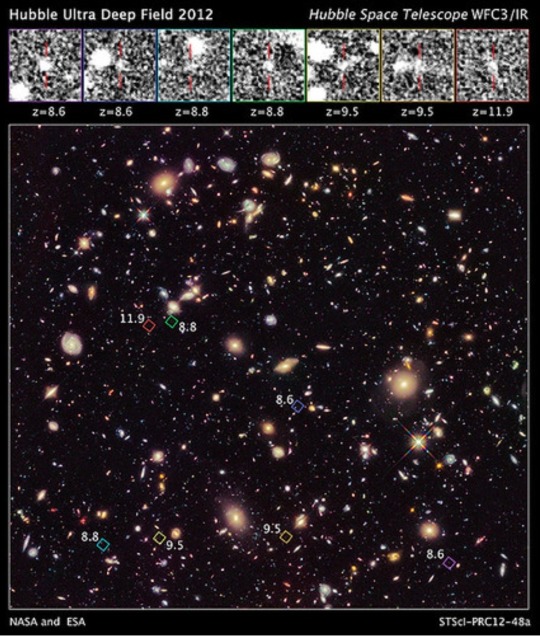
As of this writing it seems that one of the galaxies in this recent Hubble discovery may be a distance record breaker - it was observed 380 million years after the Big Bang, with a redshift of 11.9. This means the light from this galaxy (pictured below) left 13.3+ billion light years ago.

Just under a month ago, the current candidate was this object: a young galaxy called MACS0647-JD. It's only a tiny fraction of the size of our Milky Way - and was observed at 420 million years after the Big Bang, when the universe was 3 percent of its present age of 13.7 billion years. To spot this galaxy, astronomers used the powerful gravity from the massive galaxy cluster MACS J0647+7015 to magnify the light from the distant galaxy; this effect is called gravitational lensing

Originally published on imagine.gsfc.nasa.gov
COMING UP!!
(Wednesday, November 15th, 2023)
"WHERE DID WATER COME FROM ON EARTH??"
#astronomy#outer space#alternate universe#astrophysics#universe#spacecraft#white universe#space#parallel universe#astrophotography
89 notes
·
View notes
Photo

Fornax Cluster in Motion
Credits: Columbia Univ., CXC, NASA
46 notes
·
View notes
Text
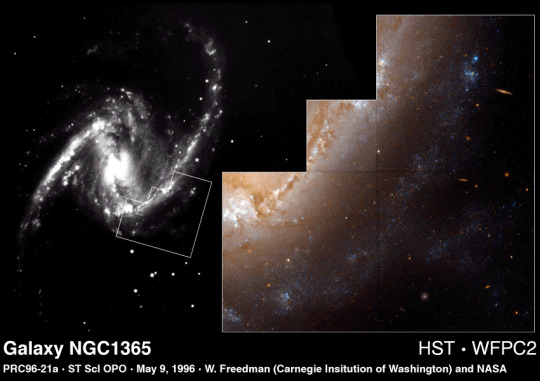
Hubble's Constant and The Expanding Universe (I) - May 13th, 1996.
"Our Universe is expanding. Distant galaxies appear to recede from us at ever-increasing speeds. What is the rate of expansion? How long has it been expanding? What will be its ultimate fate? Two groups of astronomers were searching vigorously for answers to these fundamental questions using the Hubble Space Telescope (HST). The teams had announced conflicting measurements of the Hubble constant, a number which represents the expansion rate of the Universe. Astronomer Wendy Freedman and her collaborators used pulsating stars called Cepheids to measure the distance to galaxies, like the Fornax cluster barred spiral galaxy NGC1365 shown above. The ground based photo (left) shows an inset locating the HST image (right) which Freedman and team used to identify 50 Cepheids. Their distance and velocity measurements determined Hubble's constant to be about 80 kilometers per second per megaparsec, which meant that galaxies one megaparsec (3 million light-years) distant appear to recede from us at a speed of 80 kilometers per second. Conflicting results indicating a substantially slower expansion rate (smaller Hubble constant) were being reported by astronomer Allan Sandage and collaborators. The value of Hubble's constant was the subject of a popular public debate titled "The Scale of the Universe 1996: The Value of Hubble's Constant"."
22 notes
·
View notes
Text

Merry Christmas to everyone who celebrates! 🎄🎅🏻
Barred spiral galaxy NGC 1365 is truly a majestic island universe. 200,000 light-years across and located 60 million light-years away toward the constellation Fornax, NGC 1365 is a dominant member of the well-studied Fornax Cluster of galaxies. This impressively sharp color image shows the intense, reddish star forming regions near the ends of the galaxy's central bar and along its spiral arms. Seen in fine detail, obscuring dust lanes cut across the galaxy's bright core. At the core lies a supermassive black hole. Astronomers think NGC 1365's prominent bar plays a crucial role in the galaxy's evolution, drawing gas and dust into a star-forming maelstrom and ultimately feeding material into the central black hole.
Image Credit & Copyright: Martin Pugh
#astronomy#space#science#universe#galaxy#barred spiral#barred#spiral#spiral galaxy#barred spiral galaxy#star forming#regions#Christmas#merry Christmas#supermassive black hole#black hole#follow#like#reblog#the first star#the first starr#thefirststar#thefirststarr#nasa#apod#stars#tumblr#pretty#colours#blog
82 notes
·
View notes
Text
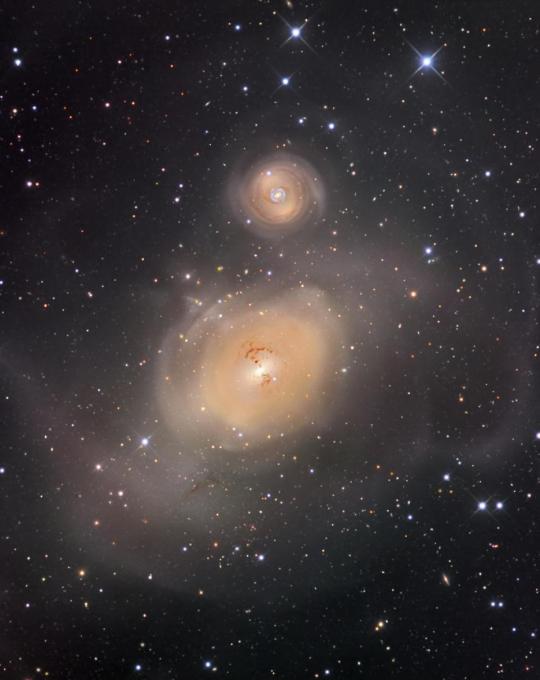
An example of violence on a cosmic scale, enormous elliptical galaxy NGC 1316 lies about 75 million light-years away toward Fornax, the southern constellation of the Furnace. Investigating the startling sight, astronomers suspect the giant galaxy of colliding with smaller neighbor NGC 1317 seen just above, causing far flung loops and shells of stars. Light from their close encounter would have reached Earth some 100 million years ago. In the deep, sharp image, the central regions of NGC 1316 and NGC 1317 appear separated by over 100,000 light-years. Complex dust lanes visible within also indicate that NGC 1316 is itself the result of a merger of galaxies in the distant past. Found on the outskirts of the Fornax galaxy cluster, NGC 1316 is known as Fornax A. One of the visually brightest of the Fornax cluster galaxies it is one of the strongest and largest radio sources with radio emission extending well beyond this telescopic field-of-view, over several degrees on the sky.
17 notes
·
View notes
Text
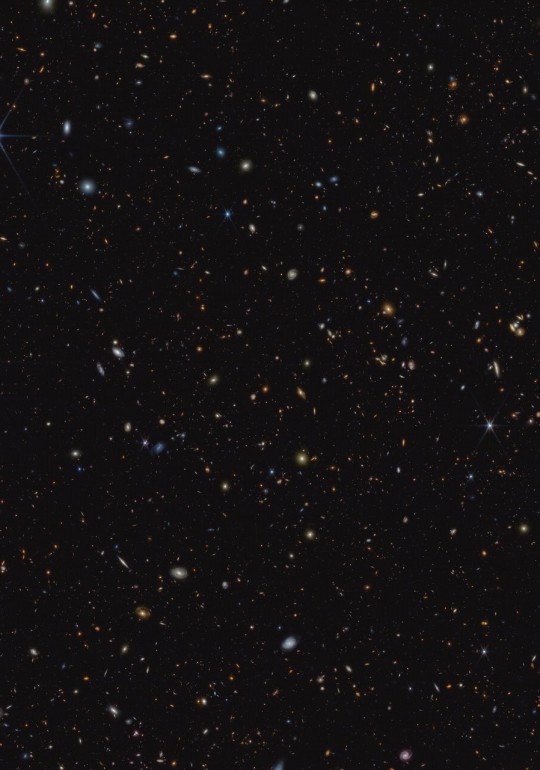
Webb's Deep Field
88 notes
·
View notes
Photo

NGC 1365: Majestic Island Universe - Martin Pugh
Barred spiral galaxy NGC 1365 is truly a majestic island universe some 200,000 light-years across. Located a mere 60 million light-years away toward the faint but heated constellation Fornax, NGC 1365 is a dominant member of the well-studied Fornax Cluster of galaxies. This impressively sharp color image shows the intense, reddish star forming regions near the ends of central bar and along the spiral arms, with details of the obscuring dust lanes cutting across the galaxy's bright core. At the core lies a supermassive black hole. Astronomers think NGC 1365's prominent bar plays a crucial role in the galaxy's evolution, drawing gas and dust into a star-forming maelstrom and ultimately feeding material into the central black hole.
2 notes
·
View notes
Photo

2023 November 2
The Fornax Cluster of Galaxies
Image Credit & Copyright: Marcelo Rivera
Explanation: Named for the southern constellation toward which most of its galaxies can be found, the Fornax Cluster is one of the closest clusters of galaxies. About 62 million light-years away, it's over 20 times more distant than our neighboring Andromeda Galaxy, but only about 10 percent farther along than the better known and more populated Virgo Galaxy Cluster. Seen across this three degree wide field-of-view, almost every yellowish splotch on the image is an elliptical galaxy in the Fornax cluster. Elliptical galaxies NGC 1399 and NGC 1404 are the dominant, bright cluster members toward the bottom center. A standout, large barred spiral galaxy, NGC 1365, is visible on the upper right as a prominent Fornax cluster member.
∞ Source: apod.nasa.gov/apod/ap231102.html
143 notes
·
View notes
Photo

The Fornax Cluster of Galaxies : Named for the southern constellation toward which most of its galaxies can be found, the Fornax Cluster is one of the closest clusters of galaxies. About 62 million light-years away, it is almost 20 times more distant than our neighboring Andromeda Galaxy, and only about 10 percent farther than the better known and more populated Virgo Galaxy Cluster. Seen across this two degree wide field-of-view, almost every yellowish splotch on the image is an elliptical galaxy in the Fornax cluster. Elliptical galaxies NGC 1399 and NGC 1404 are the dominant, bright cluster members toward the upper left (but not the spiky foreground stars). A standout barred spiral galaxy NGC 1365 is visible on the lower right as a prominent Fornax cluster member. via NASA
804 notes
·
View notes
Text
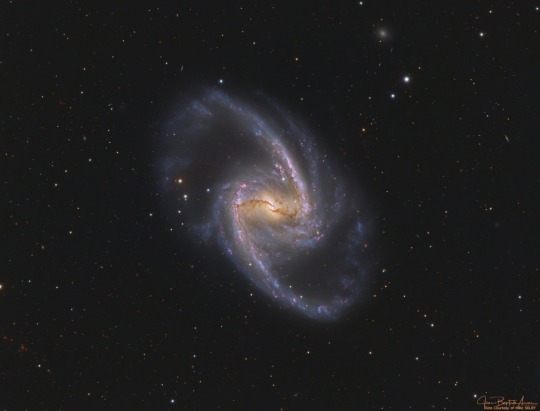
APOD February 1, 2024
NGC 1365: Majestic Island Universe
Barred spiral galaxy NGC 1365 is truly a majestic island universe some 200,000 light-years across. Located a mere 60 million light-years away toward the faint but heated constellation Fornax, NGC 1365 is a dominant member of the well-studied Fornax Cluster of galaxies. This sharp color image shows the intense, reddish star forming regions near the ends of the galaxy's central bar and along its spiral arms. Seen in fine detail, obscuring dust lanes cut across the galaxy's bright core. At the core lies a supermassive black hole. Astronomers think NGC 1365's prominent bar plays a crucial role in the galaxy's evolution, drawing gas and dust into a star-forming maelstrom and ultimately feeding material into the central black hole.
©Jean-Baptiste Auroux
0 notes
Text
just like the 88 keys of a piano and its strings
(Waiting) for a clear connection with another is like waiting for a message from outer space…
@ engineers_feed
There are 88 recognized star constellations in our night sky.
7.11.23 • 6:09am • Twitter
@sciencescroll_
For anyone interested in knowing the names of all 88 recognized constellations, here they are:
1. Andromeda
2. Antlia
3. Apus
4. Aquarius
5. Aquila
6. Ara
7. Aries
8. Auriga
9. Boötes
10. Caelum
11. Camelopardalis
12. Cancer
13. Canes Venatici
14. Canis Major
15. Canis Minor
16. Capricornus
17. Carina
18. Cassiopeia
19. Centaurus
20. Cepheus
21. Cetus
22. Chamaeleon
23. Circinus
24. Columba
25. Coma Berenices
26. Corona Australis
27. Corona Borealis
28. Corvus
29. Crater
30. Crux
31. Cygnus
32. Delphinus
33. Dorado
34. Draco
35. Equuleus
36. Eridanus
37. Fornax
38. Gemini
39. Grus
40. Hercules
41. Horologium
42. Hydra
43. Hydrus
44. Indus
45. Lacerta
46. Leo
47. Leo Minor
48. Lepus
49. Libra
50. Lupus
51. Lynx
52. Lyra
53. Mensa
54. Microscopium
55. Monoceros
56. Musca
57. Norma
58. Octans
59. Ophiuchus
60. Orion
61. Pavo
62. Pegasus
63. Perseus
64. Phoenix
65. Pictor
66. Pisces
67. Piscis Austrinus
68. Puppis
69. Pyxis
70. Reticulum
71. Sagitta
72. Sagittarius
73. Scorpius
74. Sculptor
75. Scutum
76. Serpens
77. Sextans
78. Taurus
79. Telescopium
80. Triangulum
81. Triangulum Australe
82. Tucana
83. Ursa Major
84. Ursa Minor
85. Vela
86. Virgo
87. Volans
88. Vulpecula
7.11.23 • 11:16am • Twitter
the night sky is “silent” yet still playing a universal symphony orchestrated by our beautiful mysterious Creator
like instrumental music and poetry, we see and hear things in nature just as we see written words
words that when taken inside become intertwined with our own heart and thought-life (the heart is where desire is “conceived” just as speech)
with God addressing Job:
Can you bind together a cluster of twinkling stars—
the seven sisters of Pleiades who keep company in the night sky?
Can you loosen the cords of Orion’s bow?
Can you lead the stars of the Zodiac out in their proper seasons
and guide the Bear with her cubs?
Do you know the rules of the heavens,
or apportion their influence on the seasons of the earth?
The Book of Job, Chapter 38:31-33 (The Voice)
God orchestrates “signs” in the heavens even as the stars align, yet we have no need of things such as astrology or horoscopes as forms of fortune-telling which are idolatrous in nature.
Israel in the course of their History went astray time and again from God’s truth, and some still don’t yet see their Messiah in Yeshua who the writing of the Hebrew Bible (Tanakh) points to. did you know there is a point in the world’s fiction that can become idolatry when it takes all the time of the heart & mind rather than focusing on our Creator and His truth as what is most sacred and treasured inside?
And we can see the rebirth of Israel on earth as a clear sign of God restoring the Jewish people and all Gentile believers are actually “ingrafted” into the Jewish Vine and its pure “Root” of Yeshua as Messiah over all of us
from the 36th chapter of the prophet Ezekiel:
Eternal One: On the day I cleanse you from all your sins, I will bring people back into your desolate cities, and heaps of rubble will be turned into grand structures. The wasteland will be plowed and sown—a vast change from the emptiness those passing by are used to seeing. They will be amazed, saying, “This place used to be an empty wasteland. Now it’s like the garden of Eden! The cities were demolished, lying in ruins and completely abandoned. Now they are all restored, strong and full of people!” Then the nations near you will know that I, the Eternal, am the One who rebuilt and restored the ruined cities and replanted the empty wilderness. I, the Eternal One, promise to do exactly what I’ve said.
The Book of Ezekiel, Chapter 36:33-36 (The Voice)
And we see the significance of this in the heavenly city of the new Jerusalem with its foundation stones inscribed with the 12 apostles of Yeshua and the city’s 12 gates with the 12 sons of Israel (Jacob):
Heavenly Messenger: Come with me, and I will show you the bride, the wife of the Lamb.
He took me away in the Spirit and set me on top of a great, high mountain. As I waited for what I thought was a bride, he showed me the holy city, Jerusalem, descending out of heaven from God. It gleamed and shined with the glory of God; its radiance was like the most precious of jewels, like jasper, and it was as clear as crystal. It was surrounded with a wall, great and high. There were twelve gates. Assigned to each gate was a messenger, twelve in all. And on the gates were inscribed the names of the twelve tribes of Israel’s sons. On the east wall were three gates. On the north wall were three gates. On the south wall were three gates. On the west wall were three gates. And the city wall sat perfectly on twelve foundation stones, and on them were inscribed the names of the twelve emissaries of the Lamb.
The Book of Revelation, Chapter 21:9-14 (The Voice)
A poetic post finished over 8 years ago that points us toward our heavenly “Home”
0 notes
